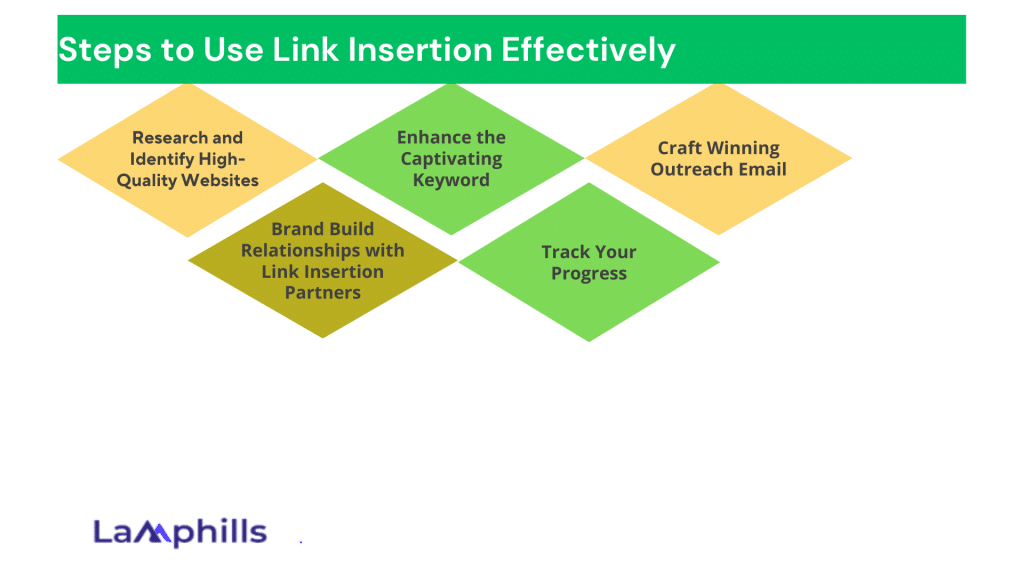As a calculated method of increasing your website’s organic traffic, exposure, and authority, link insertions are essential to maintaining a solid search engine optimization (SEO) foundation for success. According to a recent study, marketers believe that link-building will continue to have an impact on search engine rankings in the future. Because only a small portion of all internet material creates several distinct backlinks, link insertions, and other link-building tactics are invaluable. These results highlight how crucial it is to use efficient link-building strategies to improve your SEO.
In this post, I will share my discovery on what link insertions are, the difference between link insertion and guest posts, the benefits of link insertion as well as how to find link insertion websites especially if links improve SEO.
Key Takeaways
- Link insertions involve adding links to existing content, while guest posts require creating new content. While both methods aim to build backlinks and improve SEO, guest posting focuses more on creating valuable content and building relationships with online audiences.
- Identify high-authority websites in your niche, analyze their content for relevant opportunities, and personalize outreach emails highlighting the value your link offers.
- Improves SEO by increasing website authority and ranking, drives organic traffic, provides value to readers with relevant context, and is a white-hat SEO tactic.
What are Link Insertions?
In simple terms, Link insertions are just another aspect of link building and link building is just a process that guarantees the placement of a link into a pre-existing piece of content on a relevant website. This process is commonly referred to as direct outreach and it involves reaching out to a website owner for a considered backlink opportunity. link insertion involves placing a link to your website into an existing piece of content on another site. Unlike guest posts, where you write new content from scratch, link insertion leverages pre-existing content that is already indexed and has traffic. This can be incredibly powerful.
Through established connections and requesting the inclusion of a link, website or business owners aim to enhance their website’s visibility and authority on search engine results pages (SERPs). Therefore, link insertions are seen as a very reliable and useful tactic within the larger framework of link building.
By leveraging the credibility and traffic of the host website, link insertions enable the linked website to expand its online presence significantly. It is a valuable strategy that is generally used in off-page SEO.
Benefits of Link Insertion
- Improved Search Engine Rank (SEO): Success in the digital economy is closely linked to visibility. High-quality backlinks are one of the most critical factors in Google’s ranking algorithm.
- Increasing Domain Authority: The general rule in SEO is that the higher, the better. When high-authority sites link to your content, it signals to search engines that your site is trustworthy.
- Establishing Authority through Backlinks: Backlinks are the backbone of a robust AI SEO writing tools strategy.
- User Engagement and Credibility: Beyond the algorithms and rankings, link insertion plays a crucial role in shaping positive user experiences and building credibility. Links from popular sites can drive significant traffic to your site.
- Provide Value Through Interconnected Content: User engagement is the lifeblood of any website. Uncover how strategically inserted links provide additional value to users. From related articles to supplementary resources, It will guide you in creating a seamless web of interconnected content that keeps users engaged and encourages longer dwell times.
5 Steps to Use Link Insertion Effectively

Let’s break down the five steps to use link insertion effectively to achieve great results, which should be strategic and have well-thought-out tactics. These steps are based on my personal experience and what’s worked for me over the years.
#1. Research and Identify High-Quality Websites
The first and most important thing you should do is choose which websites to target. The reason for this is that simplicity and relevancy are the key components of effective link placement. Now let’s talk about strategies for locating important websites.
Utilizing search engines to locate appropriate sites is the first and simplest step in this process. Analyzing rival backlinks and keeping a watch on their tactics is another useful strategy. In this manner, you’ll be able to find websites that have links pointing to them, which might also be targeted for you. You can obtain an analytical report that includes organic competitors by taking a broad look at the domain. Make a manual search after receiving the report to confirm that they are, in fact, your competitors.
After all this, you can build a list of potential partners. And endeavor to check some factors like Relevance, Organic traffic, and Quality content before considering reaching out for collaboration.
#2. Enhance the Captivating Keyword
Once you have found the right website, the next thing that you should pay attention to is the keyword you require them to link to. So, start doing keyword research to identify relevant terms. Ensure your anchor text is descriptive and context-rich. So, it’s a must-step to maintain relevance between the chosen anchor and the content that you consider adding.
Another key step is finding keywords with high traffic and search volume yet with low keyword difficulty. This balance is extremely important for effective keyword selection.
#3. Craft Winning Outreach Email

You should give potential link-building partners a good reason why your link should be inserted into their blog posts. While this may seem easy, you need to be strategic and invest effort into writing personalized emails. Start writing compelling cold email subject lines that hook email recipients’ attention right away. This helps add a personal touch and increase the chances of getting a response. Also, try to go beyond adding the names, and collect more data to make your messaging more personalized and relevant to their needs.
#4. Build Relationships with Link Insertion Partners
The foundation of every effective link insertion strategy is establishing and preserving good connections with partners. Remember that communication that works is essential. This helps to prevent misunderstandings and keeps web administrators informed. You ought to be sensitive to criticism as well as receiving it. Honesty is important, and you should continue to communicate openly and honestly. A one-time link is not the only goal. Develop connections with bloggers and website owners. Future link-building possibilities may result from this.
Furthermore, by requesting introductions and recommendations from your current connection partners, you can make use of their network. The diversity and authority of your links will be ensured by having a large number of link partners.
#5. Track Your Progress
Track the performance of your link insertions. Use tools like Google Analytics to monitor traffic, engagement, and conversions from these links. One of the most important things you should do in the link placement process is to regularly monitor your links. You may optimize your link placement strategy by conducting audits and conversion tracking. Hence, by adhering to recommended procedures for tracking backlinks during this phase, you can obtain valuable knowledge regarding placement optimization.
What is the Difference Between Link Insertions and Guest Posts?
They are both backlinks, so what’s the difference? Link insertions and guest posting are two fairly distinctive methods that are commonly used in the realm of link building. Both of these strategies contribute to this broader objective but both are very different.
Link insertions involve making minor adjustments to already-existing content, while guest posting comprises producing original content, especially for distribution on external, topically relevant websites.
To be clear, the primary objective of these two tactics is to build backlinks to your website. Those are outside links that return users to the original website. These backlinks serve as signals to search engines, informing web crawlers of the legitimacy of your website. If your website is sufficiently relevant, search engines will direct users to it so they may find the information they require.
In contrast to link insertions, guest posting is more concerned with producing worthwhile material and cultivating trusting connections with online audiences. On the other hand, guest posting entails creating and posting content for external websites as guest authors.
Also: Download Lamphills Checklist for a well-detailed clarification about Link Insertion
Common Mistakes to Avoid in Link Insertion
Link insertion is an important aspect of content creation and website management, but it’s essential to avoid common mistakes to ensure a positive user experience and maintain the integrity of your content. Here are some common mistakes to avoid when inserting links:
- Overlinking: Overlinking a piece of material might confuse visitors and give the impression that it is spam. Give priority to quality above quantity.
- Target low-quality or spammy Sites: Don’t connect to poor-quality websites or ones that are notorious for spam or unethical behavior. Such affiliations may damage the reputation of your website.
- Not updating links: Broken links interfere with the user experience and harm the authority of your website. Make sure your links are working properly by checking and updating them frequently.
- Absent descriptive anchor text: Both visitors and search engines receive minimal context when generic anchor text is used, such as “click here” or “read more.” Use informative anchor text that explains to consumers what to expect when they click on the link instead.
- Overlooking relevance: Links ought to relate to the content contextually. Steer clear of including links that don’t add anything to the article or provide the reader with more.
- Using outdated URLs: If you’re referencing specific web pages, make sure the URLs are up-to-date.
- Over-optimized anchor text: Over-optimized anchor text can lead to potential penalties from Google, resulting in a decrease in ranking and traffic. It’s essential to keep anchor text natural and varied.
How to Find Link Insertion Websites
Now, you might be wondering, “How do I find link insertion websites?” Don’t worry; I’ve got you covered. Here’s a step-by-step guide based on my field experience.
#1. Identify Your Niche

Start by identifying websites in your niche. Use tools like Ahrefs, SEMrush, or Moz to find high-authority sites related to your industry. For example, if you’re in the tech space, look for popular tech blogs, news sites, and forums.
#2. Analyze Existing Content
Once you have a list of potential sites, analyze their content. Look for blog posts, articles, and pages that are relevant to your content. Tools like BuzzSumo can help you identify top-performing content in your niche.
#3. Reach Out
Design a compelling outreach email. Personalize it by mentioning specific details about their content and how your link adds value. Trust me, personalization goes a long way. When my sister first started, she made the mistake of sending generic emails, and her response rate was dismal. But once I informed her of personalizing them, her approach, the results were night and day and amazing.
#4. Offer Value
Explain how your link adds value to their content. Maybe it provides additional information, a different perspective, or a helpful resource. Make it clear that you’re not just asking for a favor; you’re offering something beneficial.
#5. Follow Up
Don’t be discouraged if you don’t get a response right away. Follow up after a week or so. Persistence pays off. I once followed up with a site owner a few times before they finally responded and agreed to the link insertion. And guess what? That link drove a significant amount of traffic to my site.
Does Link Insertion Improve SEO?
The question of whether link insertion is an effective backlinking strategy is a question that has generated diverse opinions. So, let’s find out several reasons why link insertion in SEO is a valuable technique for both your website and the hosting site:
- Authority and trust: Authoritative backlinks from reputable websites can improve your website’s overall authority because they are signs for search engines that your content is trustworthy.
- Improved rankings and organic traffic: Search engines love websites with a strong backlink profile and help them rank higher in search results. Plus, gaining backlinks from other websites brings organic traffic as more users find and visit your site through search results.
- Relevance and context: This strategy provides context to your content and helps search engines figure out what your content is about.
- Delivers value to readers: By adding relevant and contextual links within their content, the host website allows its readers to explore additional information or resources. This way, webmasters not only ensure a better navigation experience for their visitors but also invite them to learn more about topics they are curious about.
Remember: Download the Lamphills Checklist available for you
- It’s not against search engine guidelines: Inserting links is a legal and white-hat SEO approach you can implement without any concerns about getting penalized. While it is very safe to employ link placement, it’s also imperative to follow link-building best practices to maintain trust and authority.
- The posts are already indexed: This benefit carries quite a huge importance. When a webmaster adds your links to existing content, they’re already in Google’s index. So, you’ll witness the impact of these backlinks on your search engine rankings shortly.
- It is easy and efficient: It’s kind of a piece of cake for host website editors to insert links to an existing page. It has fewer steps compared to guest posts, where you need to find blog content ideas, and then write content.
Conclusion
Finally, we need to understand that link insertion is more than a simple keyword; it’s a strategic instrument that can completely change your online visibility. By understanding its subtleties and implementing it successfully, you can see major increases in your site’s authority, traffic, and overall SEO performance.
So, what are you waiting for? Have you ever attempted to insert a link? Which tactics proved most effective for you? Talk about it in the comments section below!
Related Articles
- Backlink Outreach: Meaning, Types & How to Build a Successful One
- SEO Outreach Explained: A Beginner’s Guide to Getting Quality Backlinks
- Spam Backlinks: The Silent Saboteurs of Your Website’s Credibility
- How to Protect Your Brand Online & Offline (Expert Tips)






